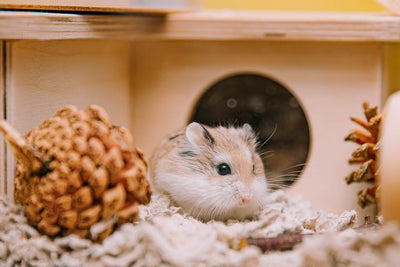Welcome to the world of entomology! In this introduction, we'll explore the fascinating realm of ant habitats and the joys of creating your very own giant ant farm kit. From the intricate tunnels to the bustling activity of the ant colony, the allure of observing these industrious creatures up close is an experience like no other. This guide will delve into the essential elements of constructing a thriving ant habitat, providing insights into the behavior of ants and the key components necessary for their well-being. Whether you're an aspiring biologist, a curious hobbyist, or a nature enthusiast, embarking on this journey to build your own ant habitat promises an enriching and educational adventure. Get ready to witness the marvels of nature in action as we delve into the world of ant farming and discover the wonders of these tiny yet remarkable creatures.

Choosing the Right Giant Ant Farm Kit
Size and Capacity
When it comes to selecting the right giant ant farm kit, there are several important factors to consider. One of the primary considerations is the size and capacity of the ant farm. A larger ant farm not only allows for more ants but also creates a captivating and immersive viewing experience. It's crucial to ensure that the ant farm can comfortably accommodate the intended ant species, providing them with ample space to thrive and exhibit natural behaviors. This may involve researching the specific space requirements of the ant species you intend to house in the farm to ensure they have an environment in which they can flourish.
Materials and Durability
The materials used in constructing the ant farm are pivotal for the well-being of the ant colony and the viewing experience. Opt for ant farms made from durable, transparent materials that facilitate easy observation of the ants' activities. This transparency not only enhances the viewing experience but also enables researchers and enthusiasts to study ant behavior. Furthermore, robust materials will prevent escapes, ensuring the safety of both the ants and the surrounding environment while contributing to the longevity of the ant farm. Additionally, consider factors such as insulation to maintain a suitable temperature for the ants and the impact of UV light on the materials over time.
Additional Features
In addition to size, capacity, and materials, it's important to evaluate any additional features that could enhance the overall experience of owning an ant farm. Integrated lighting can significantly improve visibility, allowing observers to witness the ants' day-to-day activities with clarity. This can be especially beneficial for educational or research purposes. Furthermore, look for ant farms that offer efficient feeding and watering systems, streamlining the process of caring for the ant colony. Additionally, explore expansion options that facilitate future colony growth, providing a long-term solution to accommodate the increasing population within the ant farm. It's crucial to consider these features based on your specific needs and the environment in which the ant farm will be situated, ensuring that the chosen kit aligns with your requirements and the well-being of the ant colony.
Customization and Personalization
For enthusiasts who are particularly passionate about observing and studying ants, consider the level of customization and personalization offered by different ant farm kits. Some kits may allow for the creation of diverse terrain within the farm, enabling the replication of natural habitats and behaviors. This can add depth to the observation experience and provide a more enriching environment for the ants. Additionally, consider the potential for expansion and connection to other ant farms or habitats, creating a more extensive and interconnected space for ant colonies to thrive.
Maintenance and Accessibility
A critical aspect often overlooked is the ease of maintenance and accessibility of the ant farm. Look for features that facilitate cleaning and upkeep, such as removable and easy-to-clean components. Accessibility for observation and maintenance is also crucial, ensuring that you can easily monitor the health and behavior of the ants without causing disruption to their environment. Consider features such as multiple access points and secure closures to prevent accidental escapes when tending to the ant colony.
Environmental Considerations
It's important to take into account the environmental impact of the ant farm. Look for sustainable and eco-friendly materials that align with your values and contribute to the well-being of the ants and the surrounding ecosystem. Additionally, consider the energy consumption of any integrated features, such as lighting, and explore options for minimizing environmental impact through efficient and renewable energy sources.
Conclusion
Selecting the right giant ant farm kit involves careful consideration of multiple factors, including size and capacity, materials and durability, additional features, customization and personalization, maintenance and accessibility, and environmental considerations. By prioritizing the well-being of the ant colony and aligning the features of the ant farm with your specific needs and values, you can create a captivating and sustainable environment for observing and studying these fascinating creatures.
Setting Up Your Giant Ant Farm
Assembling the Kit
Assembling the kit is the foundational step in setting up your giant ant farm. To ensure the well-being of the ant colony, carefully follow the instructions provided with the kit. The kit typically includes a formicarium, the ant habitat, along with essential accessories such as food and water dispensers. Pay close attention to detail during this process, as the environment you create will directly impact the health and vitality of the ant colony.
Selecting and Introducing Ants
Selecting the right ants for your farm is a crucial decision. When researching and choosing a species, consider factors such as the colony size, dietary needs, and behavior. It's important to select ants that are well-suited for captive environments and can thrive within the farm's conditions. Once you have identified the suitable species, introducing the ants to their new environment requires careful handling to minimize stress and ensure a smooth transition.
Creating the Perfect Environment for Your Ant Colony
Creating the perfect environment for your ant colony involves mimicking their natural habitat as closely as possible. Pay attention to factors such as temperature, humidity, and substrate to ensure the ants' comfort and well-being. Additionally, it's essential to ensure that the selected ant species are compatible with each other to maintain a harmonious and healthy ant community within the farm.
Research and understanding of the selected ant species' social structure and behavior are necessary to prevent conflicts within the colony. Some species may exhibit territorial behavior, which could lead to aggression and conflicts. By carefully setting up the ant farm and considering the well-being of the ants, you can create an educational and captivating ecosystem that offers valuable insights into the world of these industrious insects.
Caring for Your Ant Habitat
Feeding and Watering
Proper feeding and watering are essential for maintaining a healthy ant habitat. It is crucial to provide the ants with a balanced diet, including sugar and protein sources. Ants thrive when they have access to a mix of sugars and proteins. Consider offering sugar in the form of honey, maple syrup, or sugar water, while proteins can be sourced from small insects or commercial ant protein supplements. Ensuring the colony's dietary needs are met is vital for their overall well-being. Additionally, regularly check and refill their water supply to keep them hydrated. Using a shallow dish or test tube filled with clean water allows the ants to access it without the risk of drowning.
Maintaining the Habitat
Regular maintenance is crucial to ensure the well-being of your ant colony. This includes cleaning the habitat, removing any uneaten food, and monitoring the overall health of the ants. It's important to maintain a clean and suitable environment for their growth and development. Periodically inspect the habitat for mold, fungi, or any signs of pest infestation, and take necessary measures to address these issues promptly. Furthermore, consider providing suitable materials for the ants to construct or repair their nests, such as sand, soil, or other natural substrates. Observing the ants' behavior and activity levels can also provide valuable insights into their well-being, allowing you to make informed adjustments to their habitat and care routines.
Creating an Enriched Environment
In addition to basic care, it's beneficial to create an enriched environment for your ant colony. This can involve introducing various tunnels, chambers, and foraging areas within the habitat to encourage natural behaviors and activities. Providing challenges like small obstacles or hiding spots can stimulate the ants' cognitive abilities and promote active engagement within the habitat. Furthermore, offering diverse food sources and investigating their foraging preferences can enrich their foraging experiences and overall environment.
Observing and Documenting
Regularly observe and document the behavior and activities of your ant colony. This can provide valuable insights into their preferences, social structure, and overall well-being. Consider keeping a journal or log to record notable observations, such as interactions between ants, foraging patterns, and any changes in the colony's size or behavior. This documentation can serve as a reference for assessing the effectiveness of your care practices and identifying any potential issues that may arise.
Seeking Professional Advice
If you encounter any challenges or notice concerning changes in your ant colony's behavior or health, consider seeking advice from professionals with experience in ant care. Consulting with entomologists or experienced ant enthusiasts can offer valuable guidance and support in addressing complex issues or unique requirements specific to certain ant species. Their expertise can contribute to enhancing the well-being of your ant colony and resolving any care-related concerns effectively.
Observing and Learning from Your Ants
Behavior and Communication in Ants
Ants are fascinating creatures that exhibit complex behaviors and communication within their colonies. Their intricate social structure involves various roles such as workers, soldiers, and the queen, each with specific tasks and responsibilities. Their communication methods, including the use of pheromones and tactile signals, enable them to coordinate activities such as foraging, defending the colony, and caring for their young. By closely observing their interactions and foraging patterns, we can gain valuable insights into their social organization and the ways in which they effectively communicate with one another, offering a fascinating window into the world of these tiny yet highly organized insects.
Educational Value of Ant Observation
Studying ants can be an incredibly enriching educational experience for both children and adults. It offers a unique opportunity to learn about teamwork, problem-solving, and the interconnectedness of living organisms. Through hands-on observation of ant behavior, individuals can gain a deeper appreciation for the natural world and develop a better understanding of the delicate balance of ecosystems. Furthermore, observing ants in their natural habitat can inspire curiosity and critical thinking, fostering an early interest in biology and entomology among young learners. Additionally, incorporating ant observation into educational curricula can encourage the development of important skills such as patience, attention to detail, and the scientific method, providing a holistic learning experience that extends beyond traditional classroom settings.
Ant Farm Projects
Creating an ant farm can be an engaging and educational activity for individuals of all ages. It offers a close-up view of ant behavior and provides an opportunity to witness firsthand how ants construct tunnels, organize their living spaces, and care for their young. This interactive approach to ant observation allows participants to gain a deeper understanding of ant colonies' social dynamics and the resourcefulness of these remarkable insects. Additionally, maintaining an ant farm can teach responsibility and empathy as individuals take on the role of caretakers for their tiny inhabitants, fostering a sense of connection with the natural world.
Environmental Impact
Understanding the role of ants in the environment is crucial for appreciating their significance in ecological systems. Ants play various roles, such as seed dispersers, predators of pest insects, and contributors to soil aeration. By observing their foraging behaviors and interactions with other organisms, individuals can recognize the intricate connections between ants and the larger ecosystem. This awareness can cultivate a sense of environmental responsibility and encourage efforts to preserve habitats that support diverse ant populations, ultimately contributing to the conservation of biodiversity.
In summary, observing and learning from ants offers a wealth of educational and environmental insights. Whether through direct observation in natural settings, the creation of ant farms, or studying their ecological impact, the world of ants provides a captivating avenue for fostering curiosity, learning, and a deeper appreciation for the natural world.
Conclusion
The. Giant Ant Farm Kit Offers an engaging and educational experience for individuals of all ages. By creating a custom ant habitat, users can observe the fascinating behavior and social structure of ants firsthand. This kit not only provides entertainment but also serves as a valuable learning tool, fostering an appreciation for the natural world and promoting a sense of responsibility towards all living creatures. Whether for personal enjoyment, educational purposes, or as a unique gift, the Giant Ant Farm Kit offers a memorable and enriching experience for anyone curious about the intricate lives of ants.






